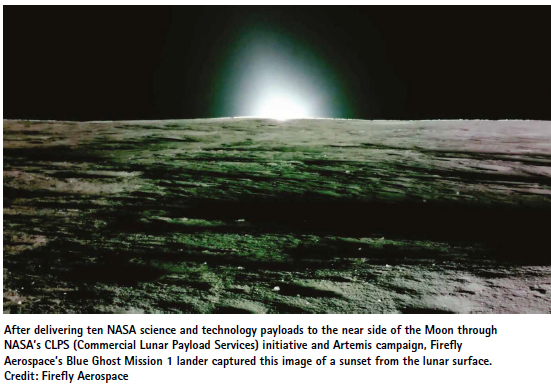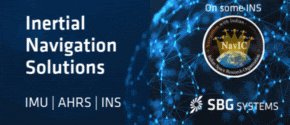| Imaging | |
Imaging
After landing on the Moon with NASA science and technology demonstrations March 2, Firefly Aerospace’s Blue Ghost Mission 1 concluded its mission March 16. Analysis of data returned to Earth from the NASA instruments continues, benefitting future lunar missions.
As part of NASA’s CLPS (Commercial Lunar Payload Services) initiative and Artemis campaign, Firefly’s Blue Ghost lunar lander delivered 10 NASA science and technology instruments to the Mare Crisium basin on the near side of the Moon. During the mission, Blue Ghost captured several images and videos, including imaging a total solar eclipse and a sunset from the surface of the Moon. The mission lasted for about 14 days, or the equivalent of one lunar day, and multiple hours into the lunar night before coming to an end.
All 10 NASA payloads successfully activated, collected data, and performed operations on the Moon. Throughout the mission, Blue Ghost transmitted 119 gigabytes of data back to Earth, including 51 gigabytes of science and technology data. In addition, all payloads were afforded additional opportunities to conduct science and gather more data for analysis, including during the eclipse and lunar sunset.
Among other achievements, many of the NASA instruments performed f irst-of-their-kind science and technology demonstrations, including: • The Lunar Instrumentation for Subsurface Thermal Exploration with Rapidity is now the deepest robotic planetary subsurface thermal probe, drilling up to 3 feet and providing a first-of-its kind demonstration of robotic thermal measurements at varying depths.
• The Lunar GNSS Receiver Experiment acquired and tracked Global Navigation Satellite Systems (GNSS) signals, from satellite networks such as GPS and Galileo, for the first time enroute to and on the Moon’s surface. The LuGRE payload’s record-breaking success indicates that GNSS signals could complement other navigation methods and be used to support future Artemis missions. It also acts as a stepping stone to future navigation systems on Mars.
• The Radiation Tolerant Computer successfully operated in transit through Earth’s Van Allen belts, as well as on the lunar surface into the lunar night, verifying solutions to mitigate radiation effects on computers that could make future missions safer for equipment and more cost effective

. • The Electrodynamic Dust Shield successfully lifted and removed lunar soil, or regolith, from surfaces using electrodynamic forces, demonstrating a promising solution for dust mitigation on future lunar and interplanetary surface operations.
• The Lunar Magnetotelluric Sounder successfully deployed five sensors to study the Moon’s interior by measuring electric and magnetic fields. The instrument allows scientists to characterize the interior of the Moon to depths up to 700 miles, or more than half the distance to the Moon’s center.
• The Lunar Environment heliospheric X-ray Imager captured a series of X-ray images to study the interaction of the solar wind and Earth’s magnetic f ield, providing insights into how space weather and other cosmic forces surrounding Earth affect the planet.
• The Next Generation Lunar Retroreflector successfully reflected and returned laser light from two Lunar Laser Ranging Observatories, returning measurements allowing scientists to precisely measure the Moon’s shape and distance from Earth, expanding our understanding of the Moon’s inner structure.
• The Stereo Cameras for Lunar Plume-Surface Studies instrument captured about 9,000 images during the spacecraft’s lunar descent and touchdown on the Moon, providing insights into the effects engine plumes have on the surface. The payload also operated during the lunar sunset and into the lunar night.
• The Lunar PlanetVac was deployed on the lander’s surface access arm and successfully collected, transferred, and sorted lunar soil using pressurized nitrogen gas, demonstrating a low cost, low-mass solution for future robotic sample collection.
• The Regolith Adherence Characterization instrument examined how lunar regolith sticks to a range of materials exposed to the Moon’s environment, which can help test, improve, and protect spacecraft, spacesuits, and habitats from abrasive lunar dust or regolith.
The data captured will benefit humanity in many ways, providing insights into how space weather and other cosmic forces may impact Earth. Establishing an improved awareness of the lunar environment ahead of future crewed missions will help plan for long-duration surface operations under Artemis.
To date, five vendors have been awarded 11 lunar deliveries under CLPS and are sending more than 50 instruments to various locations on the Moon, including the lunar South Pole and far side. www.nasa.gov x
Vexcel Imaging announces the newest UltraCam Osprey 4.2
Vexcel Imaging introduces the UltraCam Osprey 4.2, the latest evolution in large format nadir and oblique aerial imaging technology. The new 4.2 model offers 27% greater flight line efficiency with a swath width of over 25,000 pixels in nadir, along with enhanced operational f lexibility – reducing costs and improving coverage. It delivers the highest-detail photogrammetric image quality, ensuring maximum productivity for 3D city modeling, infrastructure monitoring, and high-precision urban mapping applications.
The UltraCam Osprey 4.2 is the first Vexcel system to feature the cutting-edge 247 MP Sony IMX811 CMOS sensor in combination with custom Vexcel lenses, fully resolving the new CMOS sensor. Built with an advanced panchromatic nadir channel, the system delivers precise measurements for superior feature extraction, providing the best foundation for creating demanding derivative data products like 3D city models. The UltraCam Osprey 4.2 is available in two lens configurations for enhanced operational flexibility and minimized dependence on airspace restrictions.
NSTC names Pingtung as Taiwan’s space launch site
Taiwan’s National Science and Technology Council (NSTC) recently announced that it has selected Jiupeng Village in Pingtung County’s Manjhou Township as the location for the country’s national space mission launch site. The decision was the result of a comprehensive review conducted by an inter-agency panel, which evaluated environmental conditions, launch conditions, development execution, and potential for further development, according to a news release from the Cabinet-level NSTC. focustaiwan.tw
Bellatrix, Astroscale Japan partner for space debris removal
Bengaluru-headquartered Bellatrix Aerospace and Astroscale Japan have signed an MoU for propulsion solutions. The collaboration will address opportunities within India’s growing space market and expand to developing international markets. The partnership aims to drive active debris removal, satellite servicing, and in-orbit mobility, contributing to a cleaner and safer space environment. timesofindia.indiatimes.com
China, Pakistan to send first foreign astronaut to Chinese space station
For the first time, the Chinese space program will train a Pakistani astronaut, who will also be the first foreign astronaut to visit China’s space station.
The agreement, called the “Cooperation Agreement on the Selection, Training of Pakistani Astronauts and Participation in China’s Space Station Flight Mission,” was signed by officials from the China Manned Space Engineering Office (CMSE) and the Pakistan Space and Upper Atmosphere Research Commission (SUPARCO) on Feb. 28. www.space.com
Chandrayaan-5
approved India’s ambitious Chandrayaan-5 mission has been officially approved by the Government of India. The mission will carry a significantly larger rover—250 kg compared to the 25-kg rover ‘Pragyan’ used in Chandrayaan-3.
The Chandrayaan series has been crucial to India’s lunar exploration efforts. The f irst mission, Chandrayaan-1 (2008), conducted chemical, mineralogical, and photo-geologic mapping of the Moon.
The Chandrayaan-2 mission (2019) achieved a 98% success rate, though the lander failed in its final stage. However, the onboard high-resolution camera continues to send hundreds of images, Narayanan, also the Secretary of Department of Space.
The Chandrayaan-3 mission successfully landed the Vikram lander on the Moon’s south pole on August 23, 2023, demonstrating India’s end to-end lunar landing capabilities. Following Chandrayaan-5, ISRO is gearing up for Chandrayaan-4, expected to launch in 2027, with the goal of collecting and bringing back lunar samples to Earth. www.businesstoday.in
South Korea turning abandoned coal mine into moon mission test site
South Korea plans to transform the former mining city of Taebaek into a national testing ground for lunar resource exploration, leveraging the city’s abandoned coal mines as proving grounds for space mining technologies that could one day help extract helium-3 and rare metals from the moon’s surface.
This initiative was highlighted recently when the Korea Institute of Geoscience and Mineral Resources (KIGAM) conducted a demonstration inside a defunct tunnel of the former Hamtae mine in Taebaek, Gangwon Province. The event showcased rover prototypes equipped with autonomous navigation, soil analysis, and excavation technologies – tools that could eventually be deployed on the moon to collect valuable resources.
Taebaek, situated at an average elevation of 900 meters, is Korea’s highest city and symbolically its closest point to outer space. The environmental conditions inside its abandoned mines – complete darkness, low temperatures, rugged terrain, and limited visibility due to f ine dust – closely resemble those of the lunar south pole, making the area ideal as a pre-deployment test site of lunar exploration equipment. pulse.mk.co.kr
Planet, ESA sign deal
Planet Labs has signed a new contract with the European Space Agency on behalf of the Hellenic Ministry of Digital Governance to support the Greek National SmallSat Programme, funded by the Recovery and Resilience Fund (RRF) Greece 2.0. Using Planet’s commercial satellite data, Greece aims to inform and complement the development of their national satellite technology. www.planet.com












 (No Ratings Yet)
(No Ratings Yet)





Leave your response!